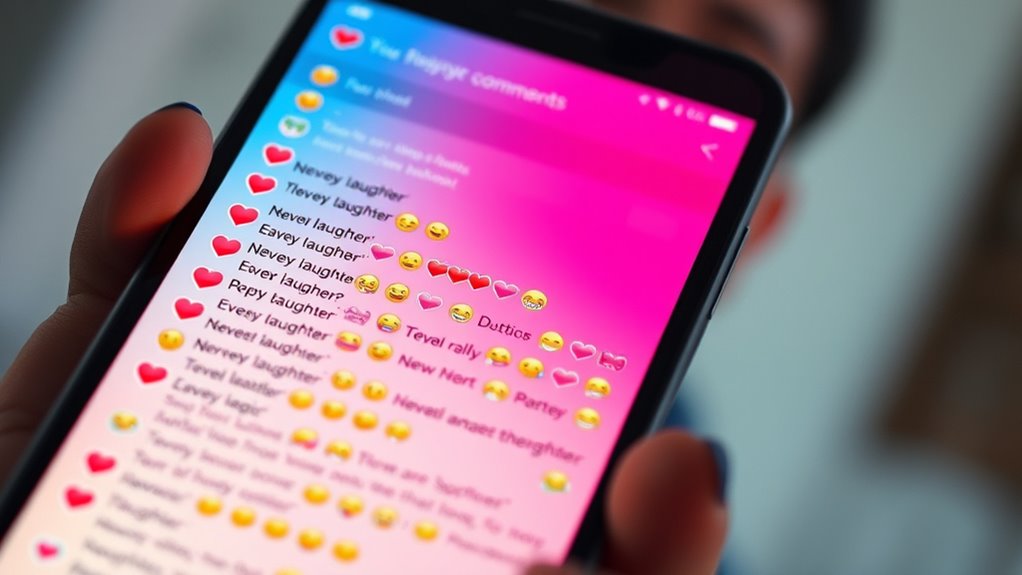Reply guys became a social media archetype because their persistent, unsolicited responses reveal deeper issues like toxic masculinity and online harassment. They often flood comment sections to assert dominance, belittle others, or seek validation, creating unwelcoming spaces. This behavior mirrors offline attitudes emphasizing control and toughness, normalizing hostility and silencing vulnerable voices. Understanding how these patterns form helps explain their rise—if you want to see how these behaviors connect to bigger societal issues, keep exploring.
Key Takeaways
- The archetype emerged from online behaviors rooted in toxic masculinity and a desire for validation through unsolicited responses.
- Persistent, aggressive commenting patterns reinforce dominance and control in social media interactions.
- Platforms’ lack of moderation allowed reply guys to normalise harassment and unwelcoming environments.
- Societal attitudes emphasizing masculinity and power translated into online harassment behaviors.
- Recognizing and challenging these behaviors helps create safer, more respectful social media spaces.

In the landscape of social media, reply guys have emerged as a recognizable archetype, often characterized by their persistent and unsolicited responses to posts. You might notice them flooding comment sections with replies that seem unnecessary or overly aggressive. They often target women or marginalized voices, believing that their responses are some form of engagement or validation. This behavior isn’t just annoying—it’s rooted in deeper issues like toxic masculinity, which encourages dominance and control over others, especially women. Reply guys sometimes see their unsolicited comments as a way to assert their masculinity, but it often comes across as an attempt to dominate conversations or belittle others. Their persistence can border on online harassment, making social media spaces uncomfortable and unwelcoming for many users. Understanding social media dynamics can help contextualize why these behaviors proliferate online.
This archetype has become increasingly common because social media provides a platform for people to express opinions with little accountability. When reply guys jump into threads, they often feel entitled to comment, regardless of whether their input is welcomed. They might argue, dismiss, or belittle others to maintain a sense of power or superiority. Over time, their behavior can reinforce harmful stereotypes about masculinity—suggesting that men must constantly prove their toughness or dominance online. This toxic masculinity fuels their need to respond aggressively or dismissively, often targeting women or marginalized groups who are already vulnerable to online harassment.
The rise of reply guys also highlights how social media can amplify harmful behaviors. Instead of fostering respectful dialogue, platforms sometimes become arenas for online harassment, where reply guys thrive. They often see their relentless responses as harmless banter or humor, but the truth is that they perpetuate a cycle of hostility. Their comments can serve to silence or intimidate those who already face real-world violence or discrimination. In this way, reply guys aren’t just annoying—they’re contributors to a culture that normalizes toxic masculinity and online harassment.
Understanding this archetype means recognizing that their behavior stems from deeper societal issues. The online environment often reflects offline attitudes, where traditional notions of masculinity equate to dominance and control. As a user, you might find yourself frustrated or overwhelmed by reply guys, but their persistence underscores the importance of challenging toxic masculinity and online harassment wherever you see it. By calling out or ignoring these behaviors, you contribute to creating a safer, more respectful social media space. It’s a reminder that online interactions should promote understanding, not hostility.
Frequently Asked Questions
How Did the Term “Reply Guy” Originate?
You might wonder how the term “reply guy” originated, especially in the context of gender dynamics and online harassment. It emerged as a way to describe men who repeatedly comment on women’s posts, often in a condescending or unwanted manner. Over time, it became a social media archetype highlighting these behaviors, spotlighting the ongoing issues of online harassment and the imbalance in digital gender interactions.
Are All Reply Guys Intentionally Harmful?
Oh, the classic reply guy—are they all villains? Not exactly. Some genuinely think they’re helping, but their comments often reinforce harmful gender dynamics and contribute to online harassment. While a few aim to be helpful, many don’t realize their tone shifts into condescension or entitlement. So, no, not all reply guys are intentionally harmful, but their presence can perpetuate negativity, whether they mean to or not.
How Can Users Protect Themselves From Reply Guys?
To protect yourself from reply guys, you should prioritize your privacy concerns by adjusting your account settings and limiting who can comment or message you. Be cautious about sharing personal details, and don’t hesitate to block or mute accounts that engage in online harassment. Staying vigilant and setting boundaries helps create a safer space, reducing the chances of unwanted interactions and safeguarding your mental well-being.
Do Reply Guys Have Any Positive Roles?
Did you know that some reply guys genuinely aim to help or support? While their behavior often clashes with online etiquette and breaches digital boundaries, they can sometimes spark meaningful conversations or offer expertise. These interactions can foster learning and community if managed respectfully. So, despite their reputation, reply guys do occasionally have positive roles by encouraging dialogue and sharing insights, as long as boundaries are maintained and respect is upheld.
How Does Social Media Platform Design Influence Reply Guy Behavior?
Social media platform design heavily influences reply guy behavior by emphasizing engagement metrics like likes and comments, which incentivize constant interaction. Algorithmic harassment often amplifies these behaviors, encouraging reply guys to seek attention through persistent replies. By prioritizing visibility over meaningful conversation, platforms create an environment where reply guys thrive, making it harder to foster respectful dialogue and discouraging genuine interactions.
Conclusion
You might think reply guys are just harmless commentators, but they reveal a lot about online power dynamics and gender expectations. While some see them as persistent, others view them as misguided or even frustrating. Recognizing this archetype helps you understand social media better—and maybe spot when someone’s intentions aren’t as genuine as they seem. So next time you encounter a reply guy, remember, it’s not just about the comments—it’s about the bigger digital picture.










